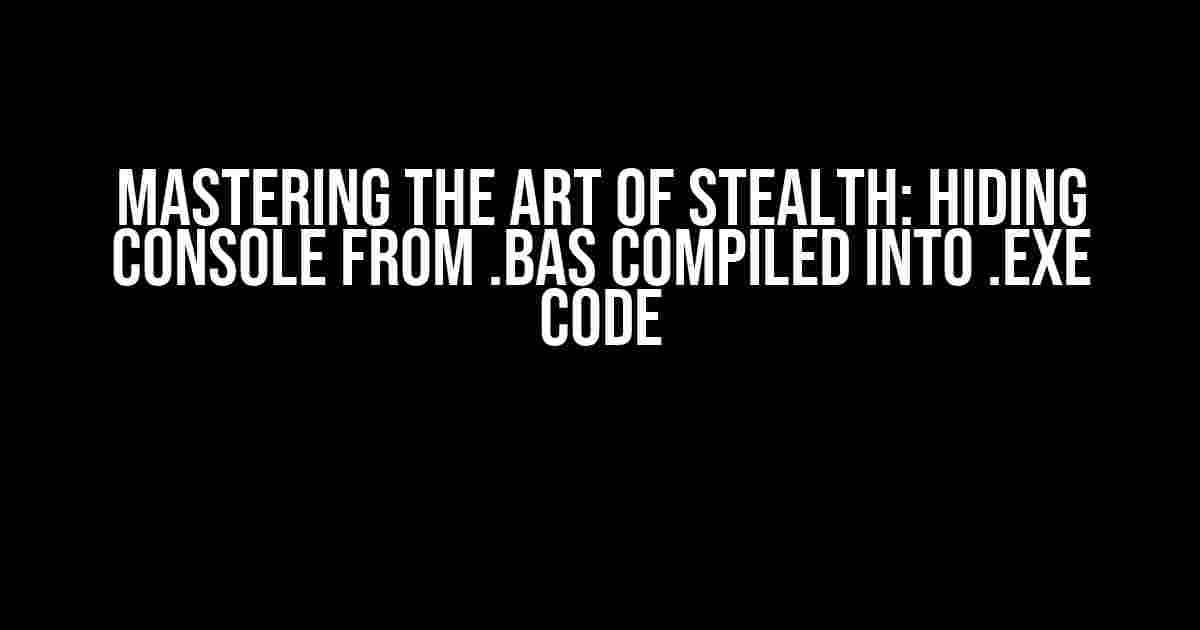As a programmer, you’ve worked tirelessly to craft the perfect .BAS program, and now you’re ready to compile it into a sleek .exe file. But, wait! You don’t want the console window to pop up every time your program runs, do you? Of course not! In this comprehensive guide, we’ll delve into the world of hiding the console from your .BAS compiled into .exe code, ensuring your program runs silently and efficiently.
Why Hide the Console?
Before we dive into the nitty-gritty, let’s discuss why hiding the console is essential:
- Professionalism**: A console-less program exudes professionalism and polish, making your software more appealing to users.
- UX Enhancement**: By hiding the console, you can focus on creating a seamless user experience, free from distractions.
- Security**: Hiding the console can help protect your program from prying eyes, making it more secure.
Understanding the Compilation Process
Before we begin, it’s essential to understand how the compilation process works:
A .BAS file is compiled into an .exe file using a compiler, such as QuickBASIC or Visual Basic. During compilation, the compiler translates the .BAS code into machine code, which is then packaged into an executable file. This process involves several stages, including:
- Lexical Analysis: The compiler breaks the .BAS code into individual tokens.
- Syntax Analysis: The compiler checks the syntax of the tokens to ensure they conform to the language’s rules.
- Semantic Analysis: The compiler analyzes the meaning of the tokens to ensure they make sense in the context of the program.
- Code Generation: The compiler generates machine code from the analyzed tokens.
- Code Optimization: The compiler optimizes the generated machine code for performance.
The Console Conundrum
By default, when you compile a .BAS file into an .exe, the console window is visible. This is because the compiler assumes you want to see the program’s output and any errors that may occur. However, this can be problematic in certain situations:
Imagine you’ve created a program that automates a task, and you want it to run silently in the background. A visible console window would be distracting and unnecessary. Or, picture this: you’ve developed a game, and the console window is spoiling the immersive experience. In these cases, hiding the console is essential.
Hiding the Console using QuickBASIC
QuickBASIC is a popular compiler for .BAS files, and luckily, it provides an easy way to hide the console:
attribute hidden
Simply add the `attribute hidden` directive at the beginning of your .BAS file, and the console window will be hidden when you compile it into an .exe file. This directive tells the compiler to suppress the console window, allowing your program to run silently.
Hiding the Console using Visual Basic
Visual Basic, on the other hand, requires a slightly different approach:
Sub Main()
' Your code here
End Sub
In Visual Basic, you need to create a `Sub Main()` procedure, which serves as the entry point for your program. Within this procedure, you can add code to hide the console window using the following API call:
Declare Sub Sleep Lib "kernel32" (ByVal dwMilliseconds As Long)
Declare Function GetConsoleWindow Lib "kernel32" () As Long
Declare Sub ShowWindow Lib "user32" (ByVal hwnd As Long, ByVal nCmdShow As Long)
Sub Main()
' Hide the console window
Dim hwnd As Long
hwnd = GetConsoleWindow()
ShowWindow hwnd, 0
' Your code here
Sleep 10000 ' Wait for 10 seconds
End Sub
In this example, we use the `GetConsoleWindow()` function to retrieve the console window’s handle, and then pass it to the `ShowWindow()` function with the `nCmdShow` parameter set to 0, which hides the window. Finally, we use the `Sleep()` function to pause the program for 10 seconds, allowing you to test the console-hiding functionality.
Using a Third-Party Tool: Resource Hacker
If you’re not comfortable modifying your .BAS code or using API calls, you can utilize a third-party tool like Resource Hacker to hide the console window:
Resource Hacker is a free utility that allows you to edit the resources of an executable file, including the console window. Here’s how to use it:
| Step | Instructions |
|---|---|
| 1 | Download and install Resource Hacker from the official website. |
| 2 | Open Resource Hacker and select “File” > “Open” to load your .exe file. |
| 3 | In the Resource Hacker window, navigate to the “RCData” section. |
| 4 | Look for the “SUBSYSTEM” resource and change its value to “WINDOWS” (without quotes). |
| 5 | Click “Compile Script” to save the changes. |
By following these steps, you’ll be able to hide the console window without modifying your .BAS code.
Conclusion
Hiding the console from your .BAS compiled into .exe code is a crucial step in creating a polished, professional program. Whether you’re using QuickBASIC, Visual Basic, or a third-party tool like Resource Hacker, the techniques outlined in this article will help you achieve a sleek, console-less experience for your users. So, what are you waiting for? Dive into the world of stealth programming and take your .BAS programs to the next level!
Remember, mastering the art of hiding the console is just the beginning. Experiment with different techniques, and don’t be afraid to push the boundaries of what’s possible. Happy coding!
Frequently Asked Question
Ever wondered how to hide that pesky console window when running a .BAS file compiled into an .exe? We’ve got the answers for you!
Q: Why does the console window appear when I run my .exe file?
When you compile a .BAS file into an .exe, the resulting executable is still a console-based application. This means it inherits the console window from the original BASIC code. To hide the console, you need to trick the compiler into thinking it’s a GUI application instead!
Q: How do I hide the console window in a .BAS file compiled into an .exe?
One way to hide the console is by adding the `/gui` compiler option when compiling your .BAS file. This tells the compiler to create a GUI application, which won’t show the console window. You can also use third-party tools or libraries that can help you achieve this.
Q: Will hiding the console window affect the functionality of my .exe file?
Hiding the console window shouldn’t affect the functionality of your .exe file, as long as you’re not relying on console input/output in your code. If you do need console I/O, you might need to find alternative ways to achieve your goals, such as using GUI-based input methods or logging to a file instead.
Q: Are there any risks or downsides to hiding the console window?
One potential risk is that errors or crashes might not be visible to the user, making it harder to debug issues. Additionally, some users might find it suspicious or untrustworthy if your .exe file doesn’t display any console output. Make sure you’ve got proper error handling and logging in place to mitigate these risks!
Q: Can I hide the console window for a specific part of my code?
While you can’t hide the console window for a specific part of your code, you can use techniques like CreateProcess or ShellExecute to run a secondary process or executable that doesn’t show the console window. This can be useful if you need to run a console-based tool or script without displaying the console output to the user.





